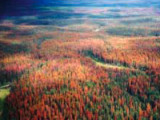THE SIZE OF A GRAIN of rice, the female mountain pine beetle is able to slip through the crevices in the bark of lodgepole, ponderosa, scots, and limber pine trees and lay her eggs. In about two weeks, the eggs hatch, releasing white larva that tunnel into the phloem of the tree, the part that transports nutrients from the roots to the limbs. They feed on the phloem through the winter, pupate in late spring, and then the mature beetles attack another tree.
Within weeks after a heavy beetle attack begins, the phloem is damaged enough to cut off the flow of nutrients and water, starving the tree. Once a tree is infested with beetles, nothing practical can be done to save it.
During the early stages of an outbreak, attacks are limited to trees already stressed by injury, fire damage, overcrowding, root disease, or old age. But as beetles become more established and numerous, they begin attacking all large trees in the area. Their natural enemies — mostly woodpeckers and clerid beetles — are able to slow their advance, but cold weather has been the biggest factor in limiting their damage. A severe freeze in late fall will kill the larvae when they are most vulnerable; one in late spring can kill them in the pupal stage. During the middle of winter, temperatures must be at least 30 degrees below zero (Fahrenheit) for five days to kill the larva burrowed deep under the bark.
In the 1990s, following a series of mild winters, pine beetle infestations in the British Columbia interior began expanding dramatically. By 2006, the Washington Post was reporting that they had infested 21 million acres in British Columbia (B.C.), killing 411 million cubic feet of trees — double the annual take by all loggers in Canada.
When climatologists talk about expected devastation from global warming, they like to show maps that depict the coastline after melting icecaps have raised the sea level 3, 10, 20, or even 50 feet. But aerial and satellite photographs of western Canadian forests already depict the grim reality of climate change — mile after mile of dead and dying pine forests.
Global warming is not some remote threat decades in the future. It is here now, and the consequences are already disturbing. Forestry experts project the mountain pine beetle will have killed 80 percent of mature pines in B.C. by the year 2013. It takes 70 years for pine trees to mature in these forests, which may never return to their past glory.
Slowing climate change requires a global effort
WHAT IS HAPPENING to the pine forests of B.C. gives us a peek into the future. A warming climate brings unexpected consequences. Some areas will become dryer; others will see increased rainfall. Some of the plants and animals that now flourish will begin struggling to survive and may become extinct. Others will thrive and expand into areas where they do not live at present.
The economic consequences of these changes will be enormous, but they may not follow a simple path. For now, the B.C. timber industry is booming. The wood in the dead trees is still usable, and forestry officials have increased limits so the trees can be harvested before they rot. Sawmills in many timber towns are working around the clock to process the lumber and ship it to builders or turn it into fuel pellets for power plants.
But one day what many loggers call “beetlewood” will be gone. So will most of the pine trees in forests that have been a valuable source of building lumber for more than a hundred years. Young trees may eventually replace them, but that will literally take a lifetime — 70 years.
Climate change is a global phenomenon, but the effects will be felt locally. Individuals, industries, and governments will be hard pressed to respond in time.
Whatever mitigation efforts nations undertake will have enormous economic and social consequences. Government policies will drive technological efforts to slow the warming. Those policies can make or break industries — and geographic regions.
We cannot afford to put all our faith in any one technology — nuclear, solar, wind, fossil fuels, or whatever else comes along. International President Newton B. Jones has said, “It is a mistake to ignore our 200 to 300 years of coal reserves as a source of energy; we must find a way to use it safely.”
Projects are already underway to explore how to sequester and store the carbon dioxide that results from burning coal and other fossil fuels. Developing this technology may be an economical way to reduce emissions.
But even as we battle global warming locally, we can never forget that it is a global phenomenon that requires a global solution. New technologies must find their way to other countries that produce high levels of emissions, such as China and India. Only truly global effort will achieve the reductions necessary.
6 Facts about Global Warming
The Bad News
- Atmospheric carbon dioxide levels have risen 30% since the start of the Industrial Revolution.
- Temperatures have risen 1.2 degrees Fahrenheit since the Industrial Revolution.
- There is abundant evidence that the two are intimately connected.
- It takes a long time for an ice sheet a mile deep to melt.
- We already have technology that can reduce emissions.
- We are fully capable of developing newer technology that does an even better job.








